2014 Peugeot 308 brakes
[x] Cancel search: brakesPage 24 of 400
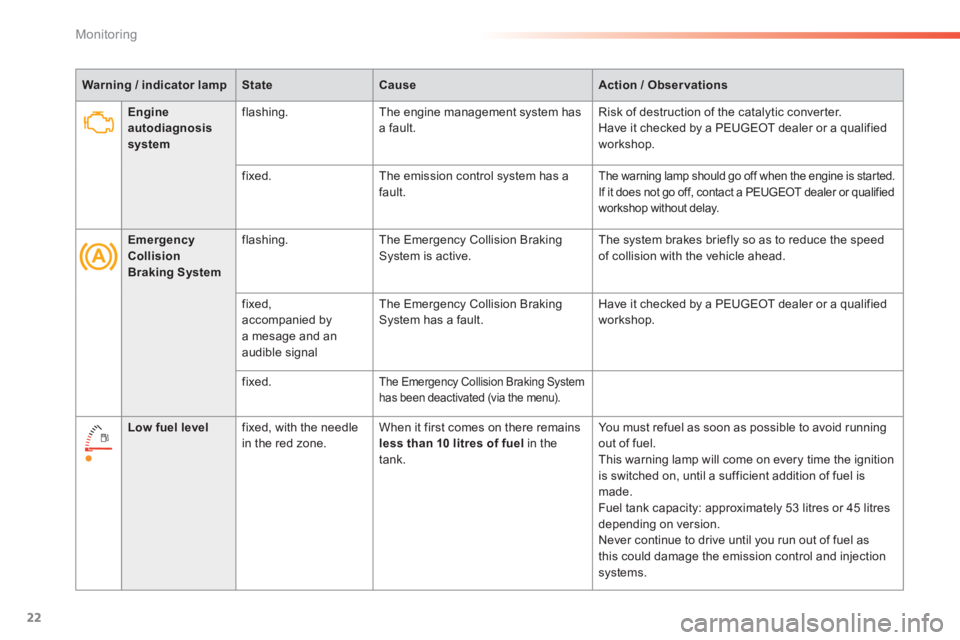
22
Monitoring
308_EN_CHAP01_CONTROLE DE MARCHE_ED02-2013
Engine autodiagnosis system
flashing. The engine management system has a fault. Risk of destruction of the catalytic converter. Have it checked by a PEUGEOT dealer or a qualified workshop.
fixed. The emission control system has a fault. The warning lamp should go off when the engine is started. If it does not go off, contact a PEUGEOT dealer or qualified workshop without delay.
Emergency Collision Braking System
flashing. The Emergency Collision Braking System is active. The system brakes briefly so as to reduce the speed of collision with the vehicle ahead.
fixed, accompanied by a mesage and an audible signal
The Emergency Collision Braking System has a fault. Have it checked by a PEUGEOT dealer or a qualified workshop.
fixed. The Emergency Collision Braking System has been deactivated (via the menu).
Warning / indicator lampStateCauseAction / Observations
Low fuel level fixed, with the needle in the red zone. When it first comes on there remains less than 10 litres of less than 10 litres of less than 10 litres offuel in the tank.
You must refuel as soon as possible to avoid running out of fuel. This warning lamp will come on every time the ignition is switched on, until a sufficient addition of fuel is made. Fuel tank capacity: approximately 53 litres or 45 litres depending on version. Never continue to drive until you run out of fuel as this could damage the emission control and injection systems.
Page 127 of 400
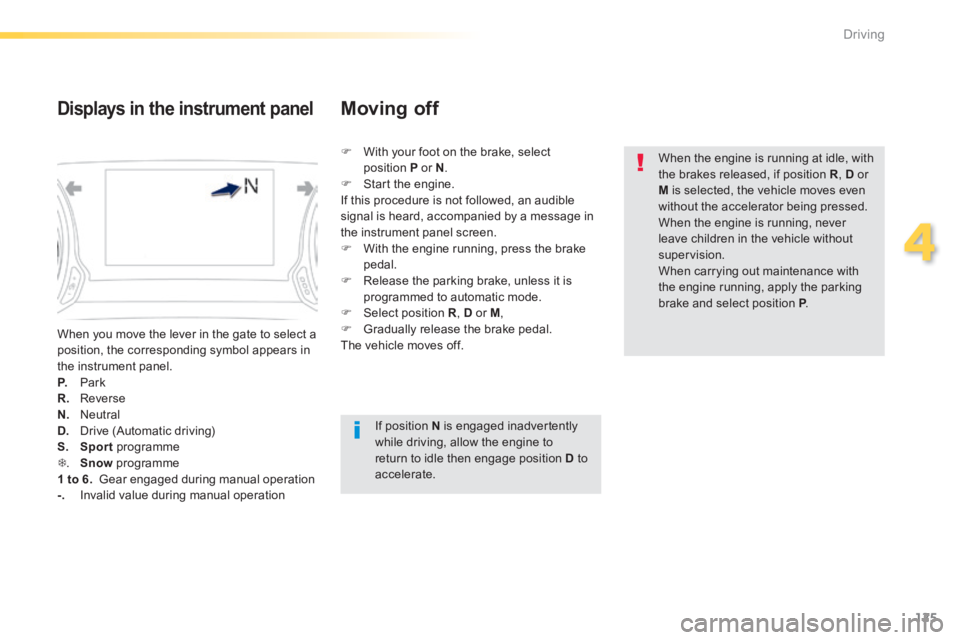
125
4
Driving
308_EN_CHAP04_CONDUITE_ED02-2013
When you move the lever in the gate to select a position, the corresponding symbol appears in the instrument panel. P. Park R. Reverse N. Neutral
D. Drive (Automatic driving) S. Sport programme . Snow programme 1 to 6. Gear engaged during manual operation -. Invalid value during manual operation
Displays in the instrument panel Moving off
With your foot on the brake, select position P or N . Start the engine. If this procedure is not followed, an audible signal is heard, accompanied by a message in
the instrument panel screen. With the engine running, press the brake pedal. Release the parking brake, unless it is programmed to automatic mode. Select position R , D or M , Gradually release the brake pedal. The vehicle moves off.
If position N is engaged inadvertently while driving, allow the engine to return to idle then engage position D to accelerate.
When the engine is running at idle, with the brakes released, if position R , D or M is selected, the vehicle moves even without the accelerator being pressed. When the engine is running, never leave children in the vehicle without supervision. When carrying out maintenance with the engine running, apply the parking brake and select position P . P . P
Page 164 of 400
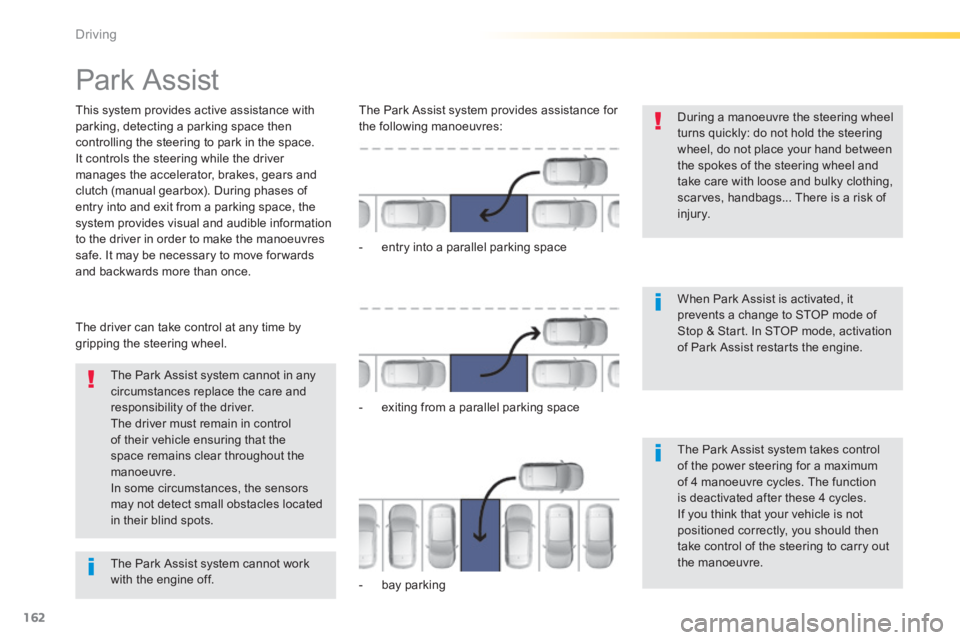
162
Driving
308_EN_CHAP04_CONDUITE_ED02-2013
Park Assist
This system provides active assistance with parking, detecting a parking space then controlling the steering to park in the space. It controls the steering while the driver manages the accelerator, brakes, gears and clutch (manual gearbox). During phases of entry into and exit from a parking space, the system provides visual and audible information
to the driver in order to make the manoeuvres safe. It may be necessary to move for wards and backwards more than once.
During a manoeuvre the steering wheel turns quickly: do not hold the steering wheel, do not place your hand between the spokes of the steering wheel and take care with loose and bulky clothing, scarves, handbags... There is a risk of injury.
When Park Assist is activated, it prevents a change to STOP mode of Stop & Start. In STOP mode, activation of Park Assist restarts the engine.
The Park Assist system cannot in any circumstances replace the care and responsibility of the driver. The driver must remain in control of their vehicle ensuring that the space remains clear throughout the manoeuvre. In some circumstances, the sensors may not detect small obstacles located in their blind spots.
The driver can take control at any time by gripping the steering wheel.
The Park Assist system provides assistance for the following manoeuvres:
- entry into a parallel parking space
- exiting from a parallel parking space
- bay parking
The Park Assist system takes control of the power steering for a maximum of 4 manoeuvre cycles. The function is deactivated after these 4 cycles. If you think that your vehicle is not positioned correctly, you should then take control of the steering to carry out the manoeuvre. The Park Assist system cannot work with the engine off.
Page 195 of 400
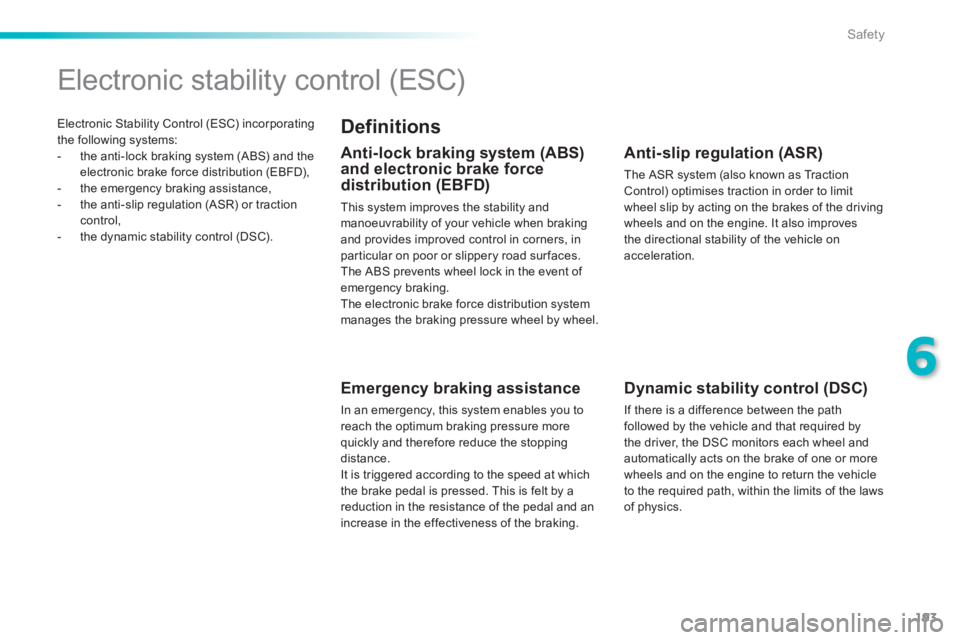
193
6
Safety
308_EN_CHAP06_SECURITE_ED02-2013
Electronic Stability Control (ESC) incorporating the following systems: - the anti-lock braking system (ABS) and the electronic brake force distribution (EBFD), - the emergency braking assistance, - the anti-slip regulation (ASR) or traction control, - the dynamic stability control (DSC).
Electronic stability control (ESC)
Definitions
Anti-lock braking system (ABS) and electronic brake force distribution (EBFD)
This system improves the stability and manoeuvrability of your vehicle when braking and provides improved control in corners, in particular on poor or slippery road sur faces. The ABS prevents wheel lock in the event of emergency braking. The electronic brake force distribution system manages the braking pressure wheel by wheel.
Emergency braking assistance
In an emergency, this system enables you to reach the optimum braking pressure more quickly and therefore reduce the stopping distance. It is triggered according to the speed at which the brake pedal is pressed. This is felt by a reduction in the resistance of the pedal and an increase in the effectiveness of the braking.
Anti-slip regulation (ASR)
The ASR system (also known as Traction Control) optimises traction in order to limit wheel slip by acting on the brakes of the driving wheels and on the engine. It also improves the directional stability of the vehicle on acceleration.
Dynamic stability control (DSC)
If there is a difference between the path followed by the vehicle and that required by the driver, the DSC monitors each wheel and automatically acts on the brake of one or more wheels and on the engine to return the vehicle to the required path, within the limits of the laws of physics.
Page 197 of 400
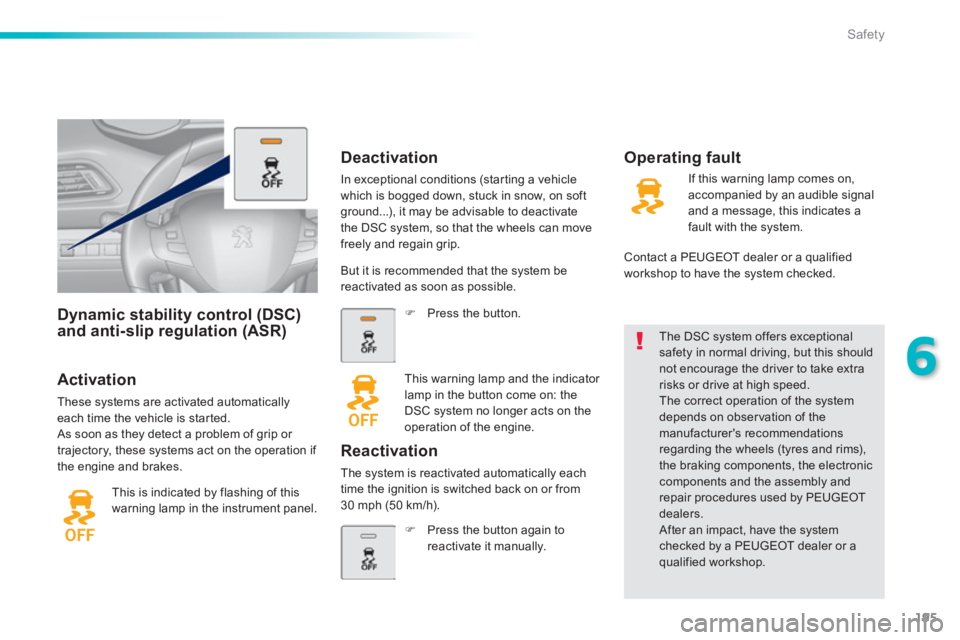
195
6
Safety
308_EN_CHAP06_SECURITE_ED02-2013
Dynamic stability control (DSC) and anti-slip regulation (ASR)
Activation
These systems are activated automatically each time the vehicle is started. As soon as they detect a problem of grip or trajectory, these systems act on the operation if the engine and brakes.
This is indicated by flashing of this warning lamp in the instrument panel.
The DSC system offers exceptional safety in normal driving, but this should not encourage the driver to take extra risks or drive at high speed. The correct operation of the system depends on observation of the manufacturer's recommendations regarding the wheels (tyres and rims), the braking components, the electronic components and the assembly and repair procedures used by PEUGEOT dealers. After an impact, have the system checked by a PEUGEOT dealer or a qualified workshop.
Deactivation
In exceptional conditions (starting a vehicle which is bogged down, stuck in snow, on soft ground...), it may be advisable to deactivate the DSC system, so that the wheels can move freely and regain grip.
Operating fault
But it is recommended that the system be reactivated as soon as possible.
Press the button.
This warning lamp and the indicator lamp in the button come on: the DSC system no longer acts on the operation of the engine.
Reactivation
The system is reactivated automatically each time the ignition is switched back on or from 30 mph (50 km/h).
Press the button again to reactivate it manually.
If this warning lamp comes on, accompanied by an audible signal and a message, this indicates a
fault with the system.
Contact a PEUGEOT dealer or a qualified workshop to have the system checked.
Page 263 of 400

261
7
Practical information
308_EN_CHAP07_INFO PR ATIQUES_ED02-2013
Driving advice
Distribution of loads
Distribute the load in the trailer so that the heaviest items are as close as possible to the axle and the nose weight approaches the maximum permitted without
exceeding it. Air density decreases with altitude, thus reducing engine performance. Above 1 000 metres, the maximum towed load must be reduced by 10 % for every 1 000 metres of altitude.
Side wind
Take into account the increased sensitivity to side wind.
Cooling
Towing a trailer on a slope increases the temperature of the coolant. As the fan is electrically controlled, its cooling capacity is not dependent on the engine speed.
To lower the engine speed, reduce your speed. The maximum towed load on a long incline depends on the gradient and the ambient temperature. In all cases, keep a check on the coolant temperature.
If the warning lamp and the STOP warning lamp come on, stop the vehicle and switch off the engine as soon as possible.
Braking
Towing a trailer increases the braking distance. To avoid overheating of the brakes on a long mountain type of descent, the use of engine braking is recommended.
Ty r e s
Check the tyre pressures of the towing vehicle and of the trailer, observing the recommended pressures.
Lighting
Check the electrical lighting and signalling on the trailer.
The rear parking sensors will be deactivated automatically if a genuine PEUGEOT towbar is used.
Refer to the "Technical data" section for details of the weights and towed loads which apply to your vehicle.
Page 286 of 400
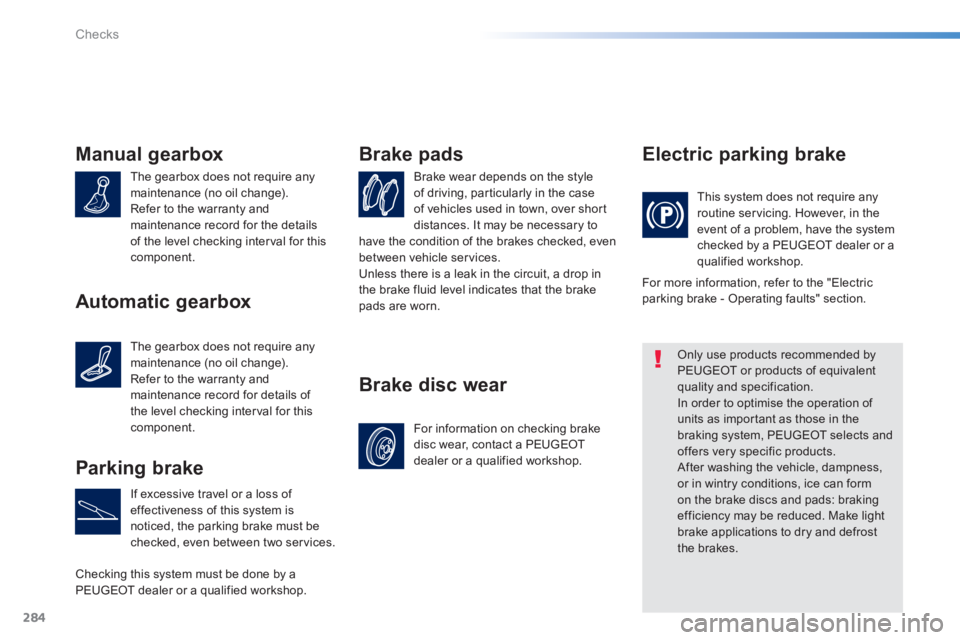
284
Checks
308_EN_CHAP08_VERIFICATIONS_ED02-2013
Manual gearbox
The gearbox does not require any maintenance (no oil change). Refer to the warranty and maintenance record for the details of the level checking interval for this component.
Brake wear depends on the style of driving, particularly in the case of vehicles used in town, over short distances. It may be necessary to
Brake pads
For information on checking brake disc wear, contact a PEUGEOT dealer or a qualified workshop.
Brake disc wear
Electric parking brake
This system does not require any routine servicing. However, in the event of a problem, have the system checked by a PEUGEOT dealer or a qualified workshop.
Only use products recommended by PEUGEOT or products of equivalent quality and specification. In order to optimise the operation of units as important as those in the
braking system, PEUGEOT selects and offers very specific products. After washing the vehicle, dampness, or in wintry conditions, ice can form on the brake discs and pads: braking efficiency may be reduced. Make light brake applications to dry and defrost the brakes.
Parking brake
If excessive travel or a loss of effectiveness of this system is noticed, the parking brake must be checked, even between two services.
Checking this system must be done by a PEUGEOT dealer or a qualified workshop.
have the condition of the brakes checked, even between vehicle services. Unless there is a leak in the circuit, a drop in the brake fluid level indicates that the brake pads are worn.
For more information, refer to the "Electric parking brake - Operating faults" section. Automatic gearbox
The gearbox does not require any maintenance (no oil change). Refer to the warranty and maintenance record for details of the level checking interval for this component.
Page 389 of 400
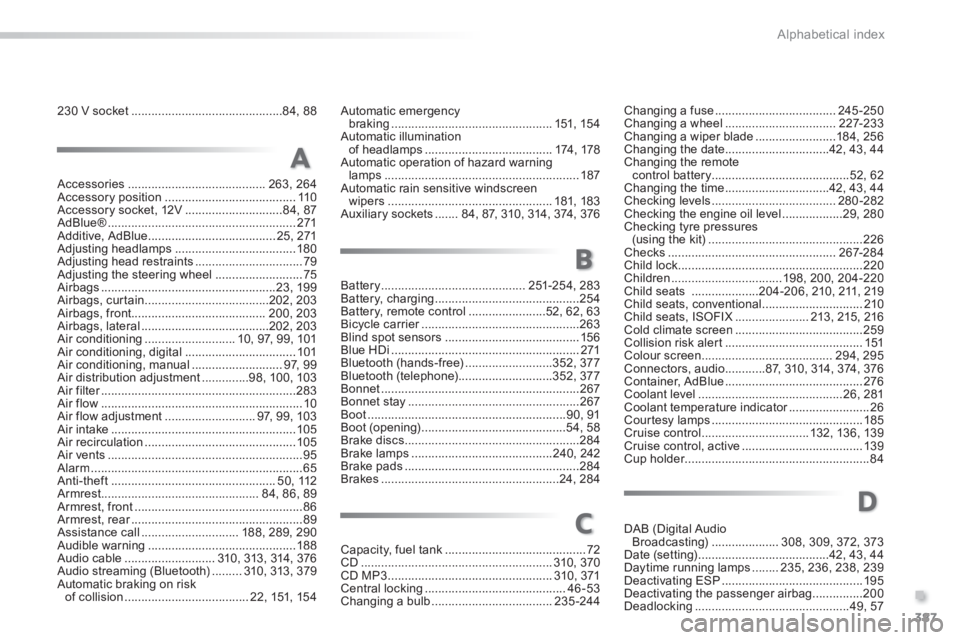
387
.
Alphabetical index
308_EN_CHAP11_INDEX ALPHA _ED02-2013
230 V socket .............................................84, 88
Accessories .........................................263, 264Accessory position .......................................11 0Accessory socket, 12V .............................84, 87AdBlue® ........................................................AdBlue® ........................................................AdBlue®271Additive, AdBlue ......................................25, 271Adjusting headlamps ....................................180Adjusting head restraints ................................79Adjusting the steering wheel ..........................75Airbags ....................................................23, 19 9Airbags, curtain .....................................202, 203Airbags, front........................................200, 203Airbags, lateral ......................................202, 203Air conditioning ...........................10, 97, 99, 101Air conditioning, digital .................................101Air conditioning, manual ...........................9 7, 9 9Air distribution adjustment ..............98, 10 0, 103Air filter ..........................................................Air filter ..........................................................Air filter283Air flow ............................................................10Air flow adjustment ...........................97, 99, 103Air intake .......................................................105Air recirculation .............................................105Air vents ..........................................................95Alarm ...............................................................65Anti-theft .................................................5 0 , 112Armrest ...............................................84, 86, 89Armrest, front ..................................................86Armrest, rear ...................................................Armrest, rear ...................................................Armrest, rear89Assistance call .............................188, 289, 290Audible warning ............................................188Audio cable ...........................310, 313, 314, 376Audio streaming (Bluetooth) .........310, 313, 379Automatic braking on risk of collision .....................................22, 151, 15 4
Automatic emergency braking ................................................151, 15 4Automatic illumination of headlamps ......................................174, 178Automatic operation of hazard warning lamps ..........................................................187Automatic rain sensitive windscreen wipers .................................................181, 183Auxiliary sockets .......84, 87, 310, 314, 374, 376
Changing a fuse ....................................245 -250Changing a wheel .................................2 27-2 3 3Changing a wiper blade ........................18 4, 256Changing the date ...............................42, 43, 44Changing the remote control battery.........................................52, 62Changing the time ...............................42, 43, 44Checking levels .....................................280-282Checking the engine oil level ..................29, 280Checking tyre pressures (using the kit) ..............................................226Checks ..................................................267-284Child lock .......................................................220Children .................................198, 200, 204-220Child seats ....................204 -206, 210, 211, 219Child seats, conventional ..............................210Child seats, ISOFIX ......................213, 215, 216Cold climate screen ......................................259Collision risk alert .........................................151Colour screen .......................................294, 295Connectors, audio ............87, 310, 314, 374, 376Container, AdBlue .........................................276Coolant level ...........................................26, 281Coolant temperature indicator ........................Coolant temperature indicator ........................Coolant temperature indicator26Courtesy lamps .............................................185Cruise control ................................132, 13 6, 13 9Cruise control, active ....................................13 9Cup holder .......................................................Cup holder .......................................................Cup holder84
A
B
C
D
Battery ...........................................251-254, 283Battery, charging ...........................................254Battery, remote control .......................52, 62, 63Bicycle carrier ...............................................Bicycle carrier ...............................................Bicycle carrier263Blind spot sensors ........................................15 6Blue HDi ........................................................271Bluetooth (hands-free) ..........................352, 377Bluetooth (telephone) ............................352, 377Bonnet ...........................................................267Bonnet stay ...................................................267Boot ...........................................................90, 91Boot (opening) ...........................................54, 58Brake discs ....................................................284Brake lamps ..........................................240, 242Brake pads ....................................................284Brakes .....................................................24, 284
Capacity, fuel tank ..........................................72CD .........................................................310, 370CD MP3 .................................................310, 371Central locking ..........................................46-53Changing a bulb ....................................235 -244
DAB (Digital Audio Broadcasting) ....................308, 309, 372, 373Date (setting) .......................................42, 43, 44Daytime running lamps ........235, 236, 238, 239Deactivating ESP ..........................................195Deactivating the passenger airbag ...............200Deadlocking ..............................................49, 57